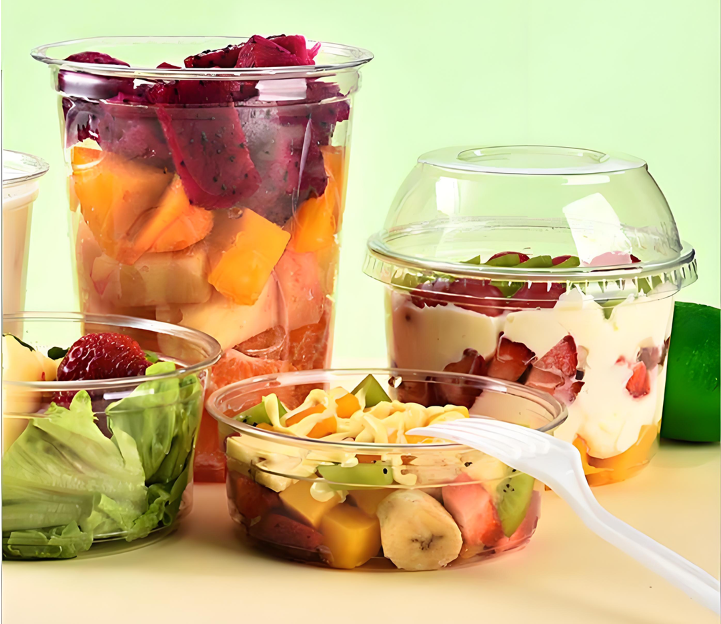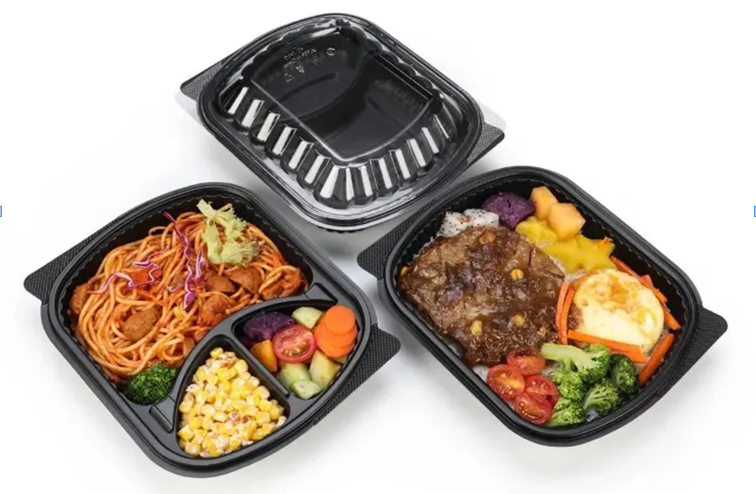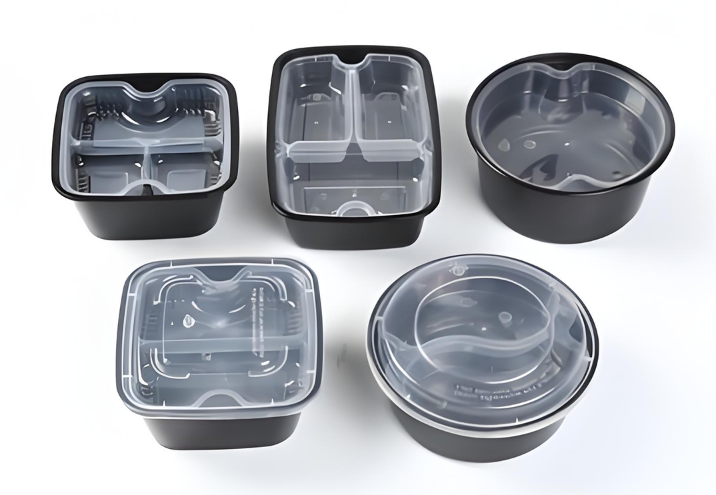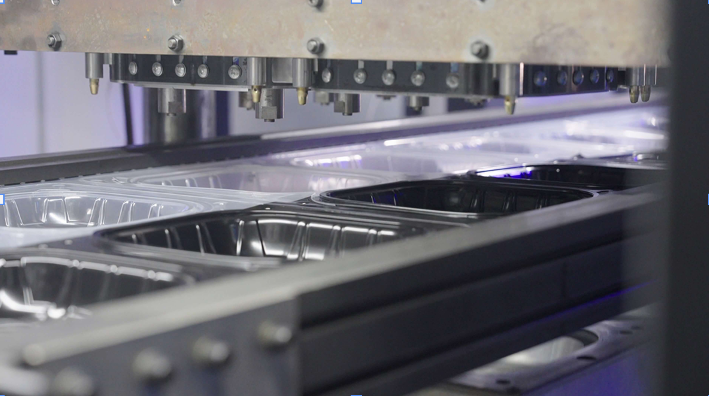PP (polypropylene) containers are a versatile and reliable material for disposable food packaging. These containers are everywhere because they are durable, safe, and effective in keeping food fresh. As a manufacturer of disposable plastic tableware, I know it’s important to understand not only what PP containers are made of, but also how they are made. The more I learned about them, the more I realized how important they are to making products that people can trust. Let’s take a closer look at the outstanding qualities of PP containers, what makes them so popular, and how they are produced.
What is a PP Container?
I think of a PP container as something light but strong, like a shield protecting my food. Made from Polypropylene, a plastic that is flexible and has a high melting point, these containers are popular in kitchens and dining tables everywhere. They can resist heat and chemicals, making them perfect for everything from salads to soups and sauces. There are many types too—bowls, trays, and hinged designs for almost any meal you can imagine. I find it amazing how these simple, versatile containers keep food fresh and ready to enjoy!
Advantages of PP Containers in Disposable Tableware
1. Durability
One great thing about PP containers is their toughness. Polypropylene is incredibly strong. It resists cracks, breaks, and the bumps from being tossed around. That’s why I trust these containers for my takeout or leftovers. They can handle every step, from delivery to storage, with no issues.
2. High Heat Resistance
These PP containers can handle temperatures from -20°C to 120°C, making them ideal for everything from hot soup to fresh salad. I like how they stay strong no matter the temperature. They keep the food fresh and secure. It’s like having a dependable partner who makes sure your meals stay just right—safe and satisfying.
3. Microwave Safe
Microwave-safe PP containers make heating food easier and safer. You can quickly pop your meal into the microwave, and the container won’t warp or leak harmful chemicals. It’s like having a reliable helper, especially when you’re in a rush for a ready-to-eat meal.
4. Chemical Resistance
PP is like a strong fortress that resists acids, bases, and oils. It keeps the contents of the container safe, locking in flavor and freshness. It also protects the product from harmful reactions. Your food stays pure, just as it was meant to be.
5. Lightweight and Cost-Effective
Polypropylene is a game-changer for manufacturers. It’s light, which lowers shipping costs. It’s also cheap to produce, making PP containers a great choice for both makers and consumers. It strikes the perfect balance between efficiency and cost-effectiveness.
6. Environmentally Friendly
I like that PP is recyclable, even though it’s not biodegradable. It gives me hope to see more manufacturers finding ways to reuse it. They turn old containers into new ones, which helps reduce waste. Some brands even offer take-back programs. This makes it easier for me to contribute to a more sustainable future. It feels like a small cycle of responsibility—use, recycle, and repeat.
The Manufacturing Process of PP Containers
The production of PP containers involves several stages, from material preparation to final product shaping. Below is an overview of the key steps involved in making PP containers for disposable tableware.
1. Material Selection and Preparation
The first step in manufacturing PP containers is selecting the appropriate grade of polypropylene resin. The resin is available in various forms, such as pellets or granules, and it is important to choose a grade that offers the necessary properties for the specific application, such as heat resistance, strength, and clarity.
The selected polypropylene is then fed into an extruder, where it is melted and formed into a continuous sheet or film. This sheet is typically cooled and solidified, creating a flat, uniform surface that can be easily molded into the desired container shape.
2. Molding and Shaping
Once the PP material is prepared, the next step is to mold and shape it into containers. There are two common techniques used for shaping PP containers:
-
Injection Molding: In this process, the molten polypropylene is injected into a mold cavity under high pressure. The mold is designed to shape the material into the desired container form, whether it be a bowl, tray, or compartmentalized container. Once the material cools and solidifies, the mold is opened, and the container is ejected. Injection molding is ideal for high-precision designs and creating complex shapes.
-
Thermoforming: Thermoforming involves heating a sheet of polypropylene until it becomes pliable and soft. The heated sheet is then placed into a mold, where it is pressed to take the shape of the mold cavity. This process is typically used for creating shallow containers like trays and clamshell packaging. After the material cools, the container is trimmed to remove any excess material.
Both injection molding and thermoforming are widely used in the production of disposable PP containers, with the choice of technique depending on the design, thickness, and production volume required.
3. Printing and Decoration
Once the PP containers are formed, manufacturers often add logos, branding, or creative designs to make them stand out. These techniques, such as screen printing, pad printing, or direct digital methods, improve the container’s appearance and provide important details, like product information, company logos, or recycling instructions. This process gives the container its own character while ensuring it remains functional.
4. Quality Control
Quality control is essential in any manufacturing process. It’s the moment when each PP container is tested to make sure it is strong, safe, and ready. This is the final step where every detail is checked, ensuring that only high-quality products reach the consumer.Containers undergo various tests, including:
- Physical Testing: Testing for strength, impact resistance, and load-bearing capacity.
- Heat Resistance Testing: Checking if the containers can withstand high temperatures without warping or deforming.
- Leakage Testing: Ensuring that containers with lids fit securely and do not leak.
- Chemical Safety Testing: Ensuring that no harmful chemicals are leached into the food during storage or heating.
The containers that pass these tough tests are the ones that can be released into the world.
5. Packaging and Distribution
Once the PP containers pass the quality checks, they are packaged and ready for shipping. They are either stacked in bulk or placed neatly into cartons for shipment to retailers or customers. Manufacturers carefully plan how they package the containers to save space and reduce shipping costs. Every inch of space is used efficiently, much like packing a suitcase for a trip.
Conclusion
PP containers are my top choice for food packaging, and it’s easy to see why. They’re strong and versatile, like a reliable friend. Whether I’m picking up takeout or preparing meals for the week, these containers handle heat and are affordable. What I love most is how they combine practicality with reliability, making my daily routine easier.
For manufacturers, crafting these containers is an art. Choosing the right polypropylene material and using proper molding techniques ensures durability. It’s not just about strength; it’s about creating something that fits with the fast-paced food world.
PP containers have proven to be a reliable and versatile solution for disposable food packaging. Their durability, heat resistance, and affordability make them ideal for use in a variety of applications, from takeout packaging to meal prep containers. Understanding the production process behind these containers is essential for manufacturers to ensure the highest quality products. By selecting the right polypropylene material and using advanced molding techniques, manufacturers can create containers that meet the demands of consumers and the food industry.
The production process of PP containers is a careful combination of technology and craftsmanship. From material selection to molding, printing, and quality control, each step is designed to ensure that the containers are not only functional but also aesthetically pleasing and safe for food storage. The molding processes—whether injection molding or thermoforming—play a key role in determining the design flexibility and production efficiency. These technologies, coupled with rigorous testing and quality assurance, ensure that the final product meets both industry standards and consumer expectations.
As the demand for sustainable packaging increases, PP containers continue to evolve, with a growing focus on recycling and reducing environmental impact. Whether you’re a food manufacturer or a consumer, PP containers offer a practical, reliable, and safe solution for everyday food packaging needs.
With more people seeking eco-friendly options, I’m excited to see these containers improve. They’re no longer just for holding food—they focus on sustainability, with an emphasis on recycling and reducing their environmental impact. Whether you’re a food manufacturer or someone who needs everyday convenience, PP containers are the hidden heroes that get the job done.




